Category G – Traffic rules
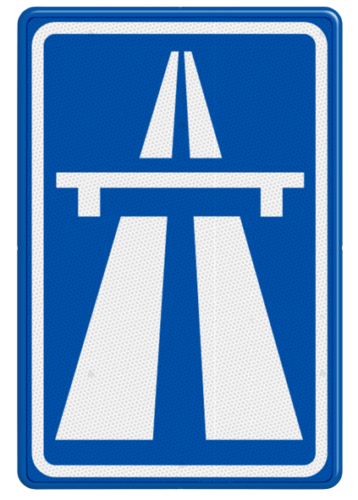 Sign G1 – Motorway.
Sign G1 – Motorway.
This sign indicates a motorway. Unless otherwise stated, a maximum speed of 130 kilometers per hour applies.
The maximum speed on a motorway is 100 kilometers per hour between 6 a.m. and 7 p.m.
Every motorway has a number, always an A number. Consider, for example, the A1, A2, and the A10. A numbers are given to motorways within the Netherlands. If the motorway crosses the border, it also receives an E number.
A motorway meets a number of characteristics and special rules apply.
A motorway road is always located outside a built-up area and the main road is always a priority road. A motorway has grade-separated intersections, separated lanes, and smoothly flowing entry and exit lanes. In addition, there is almost always an emergency lane.
Parking lots, gas stations, and bus stops located along motorways are not part of the motorway.
Use of the motorway is only permitted for drivers of a motor vehicle that may and may be driven at a speed of at least 60 km/h. A moped that can drive 80 kilometers per hour is not allowed to drive onto the motorway. He can drive at least 60 kilometers per hour, but he is not allowed to drive 60 kilometers per hour.
There is no minimum speed on a motorway. If a bridge is open or there is a stationary traffic jam, you cannot meet the minimum speed limit.
Drivers are prohibited from turning or reversing their vehicles on a motorway. It is also prohibited to leave a vehicle stationary on a motorway’s carriageway. The emergency lane is also part of the motorway, so the aforementioned prohibitions also apply to the emergency lane.
Road users are prohibited from using the emergency lane, refuge, or shoulder on a motorway except in emergencies.
On a motorway, drivers of a combination of vehicles with a total length of more than 7 meters AND of a truck are prohibited from using any lane other than the two rightmost lanes on a carriageway with three or more lanes. The ban does not apply if they have to pre-sort.
Motorways do not have equivalent junctions, so photos showing a junction with traffic lights cannot have been taken on a motorway.
If you have a breakdown on a motorway, there is often a hard shoulder where you can seek safety. Make sure you get to the emergency lane as safely as possible. Turn on the hazard lights as soon as possible. Once you are on the hard shoulder, you must pay attention to the following things: Is there a guardrail next to the hard shoulder?
If so, park the car as close to the guardrail as possible.
If not, park the car on the side of the road if possible.
Leave the car, including the passengers, and seek safety behind the guardrail. This also applies, perhaps especially, when it is dog weather.
Place the warning triangle or switch on the hazard lights.
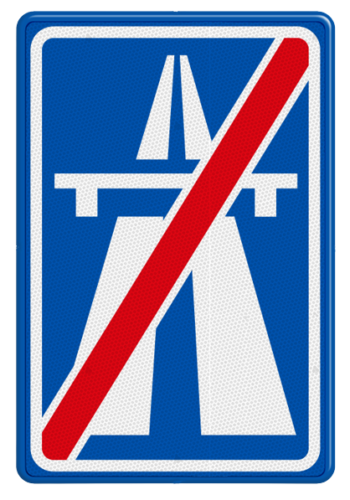 G2 – End of motorway.
G2 – End of motorway.
This sign indicates that you are leaving a motorway. Usually, you are driving into a built-up area, and then you are not allowed to drive faster than 50 kilometers per hour unless indicated otherwise.
If there are no signs indicating built-up areas and no signs indicating a maximum speed, then the maximum speed after this sign is 80 kilometers per hour.
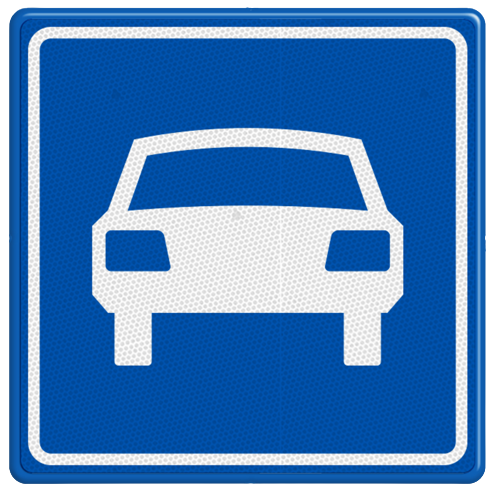 Sign G3 – Autoweg.
Sign G3 – Autoweg.
An autoweg is a road on which only motor vehicles travel, generally at a fairly high speed. It usually consists of one lane, so you may have to deal with oncoming traffic.
If you want to overtake, you have to be very confident. Overtaking on motorways regularly results in head-on collisions and the consequences are obvious.
An autoweg also has at-grade intersections.
Autowegen also features at-grade intersections, which means you may encounter pedestrians, cyclists, and other vehicles crossing the highway. Being aware of this can help you anticipate and navigate such situations more safely.
Exit lanes, which can be located on the left or right of the roadway, have usually been constructed to make leaving highways safer.
You can recognize an autoweg by sign G3. Many highways have a number. This is always an N number. A N number does not mean that the road is always an autoweg.
Parking lots, bus stops and gas stations located along a motorway do not belong to the motorway. The rules of a motorway do not apply here.
To be allowed to drive on an autoweg you must be able to drive at least 50 kilometers per hour. This does not mean that you have to drive at least 50 kilometers per hour to drive on the autoweg. If there is a traffic jam on the autoweg, there is of course no point in driving 50 kilometers per hour, but you should adapt your speed to the other traffic.
A moped that can drive 80 kilometers per hour is not allowed to drive on the motorway. He can drive at least 50 kilometers per hour, but he is not allowed to drive 50 kilometers per hour.
The maximum speed on motorways outside built-up areas is 100 kilometers per hour. However, it is not always allowed to drive 100 kilometers per hour. A maximum speed of 50 or 70 kilometers per hour applies to many autowegen, especially within built-up areas. Even if there is a maximum speed of 100 kilometers per hour, this is often lowered to 70 kilometers per hour when approaching traffic lights and often at junctions.
There are no emergency lanes along autowegen, but it is nice that if you have a breakdown, you can still safely park your car. Refuges have been constructed for this purpose. Refuges are always indicated by a small blue sign showing a car with an open hood and someone working on it.
It is not permitted to use the refuge unless your car has broken down, and parking at refuges is not permitted.
If you have a breakdown on an autoweg, there is often no hard shoulder where you can seek safety. Make sure you get to the refuge as safely as possible. Turn on the hazard lights as soon as possible. Once you are at the refuge, you should pay attention to the following things: Is there a guardrail next to the airport?
If so, park the car as close to the guardrail as possible.
If not, park the car on the side of the road if possible.
Leave the car, including the passengers, and seek safety behind the guardrail. This also applies, perhaps especially, when it is dog weather.
Place the warning triangle or switch on the hazard lights.
 G4 – End of autoweg.
G4 – End of autoweg.
This sign indicates that you are leaving an autoweg. Usually, you are driving into a built-up area, and then you are not allowed to drive faster than 50 kilometers per hour unless indicated otherwise.
If there are no signs indicating built-up areas and no signs indicating a maximum speed, then the maximum speed after this sign is 80 kilometers per hour.
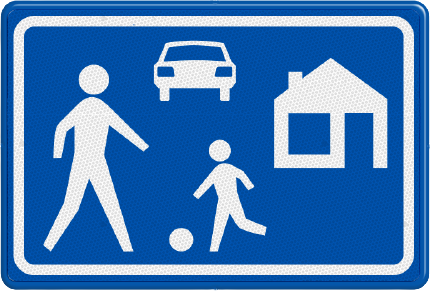 G5 – Erf (Home zone).
G5 – Erf (Home zone).
Erven are residential areas indicated by sign G5. Once you pass this sign, you drive into a yard, and the rules of a erf apply to you.
As long as you have not passed the G6 sign, you are still driving in the erf, and you must continue to follow the rules of a yard. There is no need to place an “end of erf” sign after every junction.
Many children play in erven, many people walk on the street and people live on the street. Pedestrians may use the entire width of the road, but may not stand and unnecessarily hinder motorists.
The maximum speed within an erf is 15 kilometers per hour. In the past, the maximum speed within a yard was walking pace. Because the definition of walking pace was very unclear to many people, walking pace has been changed to a maximum of 15 kilometers per hour.
Many thresholds, flower boxes, and other obstacles are placed within yards so that it is not possible to drive through yards at high speed.
At a junction within an erf, the simple rule is that drivers coming from the right should have priority over drivers coming from the left. Pedestrians from the right, therefore, do not have priority within a yard.
In an erf, parking is only permitted in designated spaces marked by sign E4 or in areas where parking spaces have been created with a sidewalk tile displaying a white “P.”
If an ERF is also designated as a parking disc zone by sign E10, you may also park in that erf along the blue lines in addition to the aforementioned places if you have clearly and visibly placed a parking disc in your car.
You are not allowed to park anywhere in an erf, but you are allowed to stop there to load/unload or to let someone get in or out.
Drivers of a car in possession of a valid disabled parking card may park outside the parking spaces if they have clearly visible this disabled parking card and a parking disc on their car.
Vehicles for disabled persons may park in an ERF outside the parking spaces all day because a vehicle for disabled persons is not a motor vehicle and, therefore, does not have to park in the parking spaces.
Pedestrians do not have to walk on the sidewalk in an erf, but may use the carriageway. This does not mean that pedestrians have priority within an erf.
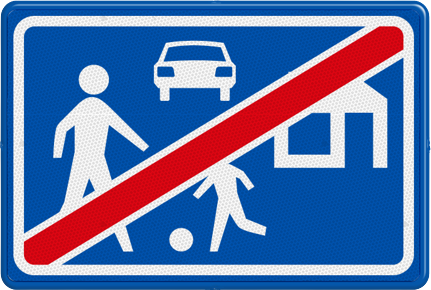 G6 – End of erf.
G6 – End of erf.
When you enter or leave an exit, you perform a special maneuver in which you must give way to all other traffic. So not only vehicles from left and right, but you have to give way to everything and everyone, including pedestrians.
Two situations can arise when leaving a property:
- The yard ends right at sign G6 and crosses another road by means of a lowered sidewalk or a lowered curb. You are now clearly leaving an exit.
- We have a different situation if sign G6 is 25 meters or further from the crossing road. The section after sign G6 is then a regular road, and the junction you approach is also not an exit and the normal priority rules apply. It is understandable that this does not promote clarity and safety and does not occur that often.
In summary, if there is no clear exit construction when leaving a property, the normal priority rules that also apply at an equivalent junction apply.
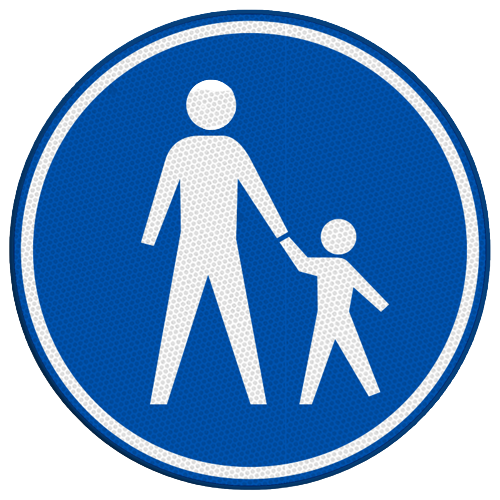 G7 – Footpath.
G7 – Footpath.
This path is only for pedestrians and drivers of vehicles for disabled persons.
Pay attention to children playing as they enter or leave the path.
Pedestrians walking with a moped, motorcycle, or other vehicle may use this path. Drivers of a vehicle for disabled persons may also use a sidewalk. With a maximum speed of 6 kilometers per hour.
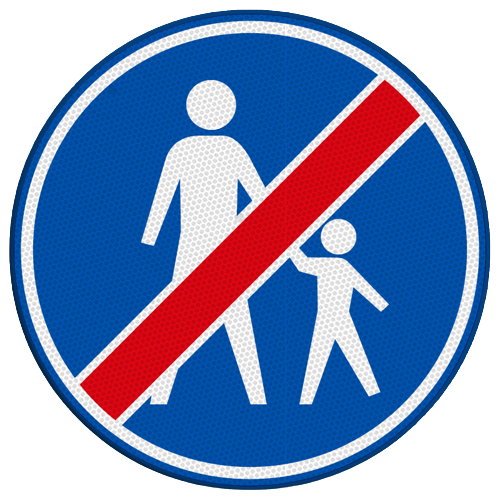 G8 – End of footpath.
G8 – End of footpath.
The meaning of this sign is clear. The footpath is over.
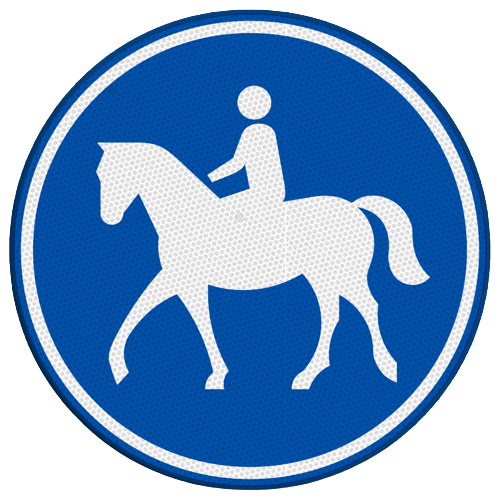 G9 – Bridle path.
G9 – Bridle path.
This path is often unpaved and only intended for horse riders. Road users other than horse riders are not allowed to use this path.
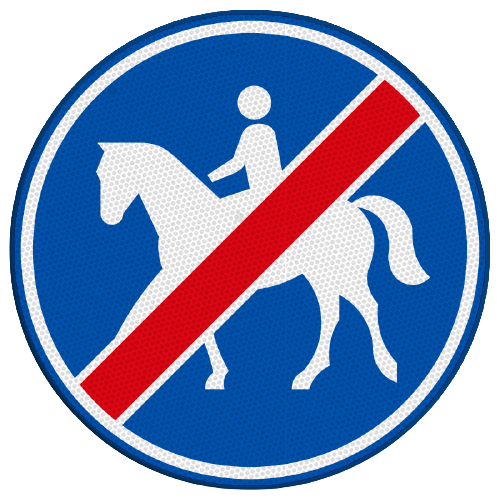 G10 – End of bridle path.
G10 – End of bridle path.
Horse riders may only use the verge or carriageway if there is no bridleway. The sidewalk, footpath, cycle path, or bicycle/moped path is not permitted.
 G11 – Mandatory cycle path.
G11 – Mandatory cycle path.
Cyclists and mopeds are obliged to use the mandatory cycle path.
Pedestrians may use the mandatory cycle path in the absence of a footpath or sidewalk.
Drivers of vehicles for disabled persons may also use the mandatory cycle path.
Road users other than cyclists, snorfietsers, drivers of vehicles for disabled persons, and pedestrians are prohibited from using a mandatory cycle path.
Some cities in the Netherlands, such as Amsterdam, ban snorfietsen from the cycle path and are then obliged to use the carriageway instead of the mandatory cycle path. This is not regulated by law, so it is not asked by the CBR during the theory exam.
 G12 – End of mandatory cycle path.
G12 – End of mandatory cycle path.
The meaning of this sign is not very surprising. After this sign, the mandatory cycle path comes to an end.
 G12a – Bicycle/moped path.
G12a – Bicycle/moped path.
Cyclists, snorfietsers, and mopeds are obliged to use the mandatory bicycle/moped path.
In the absence of a footpath or sidewalk, pedestrians may use the mandatory bicycle/moped path.
Drivers of vehicles for disabled persons may also use the mandatory bicycle/moped path.
Road users other than cyclists, snorfietsers, moped riders, drivers of vehicles for disabled persons, and pedestrians are prohibited from using a mandatory cycle path.
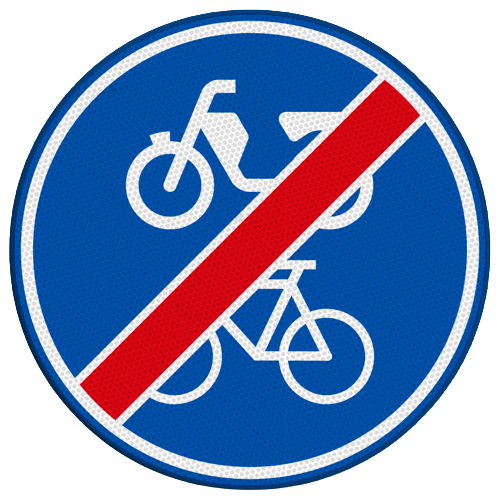 G12b – End of bicycle/moped path.
G12b – End of bicycle/moped path.
After this sign, the mandatory bicycle/moped path comes to an end.
If there are no other signs, the carriageway is now the place on the road for cyclists, snorfietsers, and mopeds.
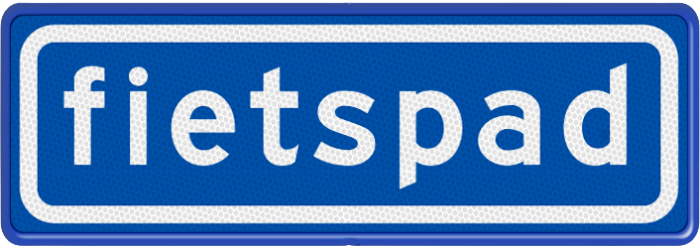 G13 – Non-mandatory cycle path.
G13 – Non-mandatory cycle path.
Cyclists are not required to ride here. They are allowed to use the carriageway instead of the mandatory cycle path, and if there is also a mandatory cycle path, they must use it.
Riders of snorfietsen equipped with a combustion engine may only use the optional cycle path with the engine switched off. Then this moped must of course have access to pedals to move forward.
Drivers of snorfietsen with an electric motor are allowed to use the optional cycle path.
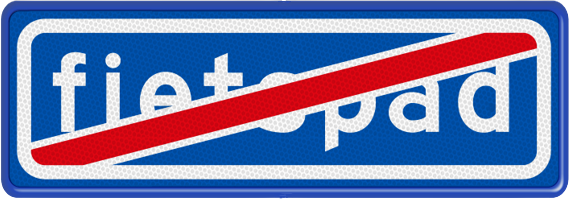 G14 – End of non-mandatory cycle path.
G14 – End of non-mandatory cycle path.
After this sign, the non-mandatory cycle path comes to an end.
The place on the road for cyclists is now the road or the mandatory cycle path if one is present.
